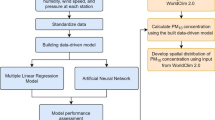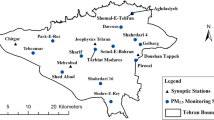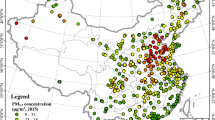Abstract
The aim of our study was to compare and evaluate four models by which the ground-level PM2.5 concentrations in the urban area are predicted. These are ordinary kriging (OK), universal kriging (UK), inverse distance weighting (IDW), and multi-layer perceptron (MLP). Root mean square error (RMSE) and standard deviation (SD) were used to select semi-variogram and the transformation type of renormalized data in kriging models. The spherical semi-variogram, Box-Cox with the power parameter equal to one, and first order trend of removal were used to run OK and UK models. In the IDW method, the weighing was conducted according to the distance between points and the measurement station. The trial and error method along with a coefficient of determination (R2) and the lowest root mean square error (RMSE) values were used to obtain the optimum model in MLP approach. Regarding the mapping, the nearest area to main roads showed generally the highest annual average concentrations of PM2.5. Based on the RMSE and R2 of models, the order of fitted models of PM2.5 concentrations in the air from the best to worst was as follows: MLP > OK > UK > IDW.





Similar content being viewed by others
References
Abdul-Wahab SA, Al-Alawi SM (2002) Assessment and prediction of tropospheric ozone concentration levels using artificial neural networks. Environ Model Softw 17:219–228
Adams MD, Kanaroglou PS (2016) Mapping real-time air pollution health risk for environmental management: Combining mobile and stationary air pollution monitoring with neural network models. J Environ Manage 168:133–141. https://doi.org/10.1016/j.jenvman.2015.12.012
Alahabadi A, Rezai Z, Rahmani-Sani A, Rastegar A, Hosseini-Bandegharaei A, Gholizadeh A (2016) Efficacy evaluation of NH4Cl-induced activated carbon in removal of aniline from aqueous solutions and comparing its performance with commercial activated carbon. Desalination Water Treat 57:23779–23789. https://doi.org/10.1080/19443994.2015.1134356
Bartier PM, Keller CP (1996) Multivariate interpolation to incorporate thematic surface data using inverse distance weighting (IDW). Comput Geosci 22:795–799. https://doi.org/10.1016/0098-3004(96)00021-0
Beelen R, Hoek G, Vienneau D, Eeftens M, Dimakopoulou K, Pedeli X, Tsai M-Y, Künzli N, Schikowski T, Marcon A (2013) Development of NO 2 and NO x land use regression models for estimating air pollution exposure in 36 study areas in Europe–the ESCAPE project. Atmos Environ 72:10–23
Berman JD, Breysse PN, White RH, Waugh DW, Curriero FC (2014) Evaluating methods for spatial mapping: applications for estimating ozone concentrations across the contiguous United States. Environ Technol Innov 3:1–10
Bohling G (2005) Introduction to geostatistics and variogram analysis. Kansas Geol Surv 1:20
Commodore A, Wilson S, Muhammad O, Svendsen E, Pearce J (2017) Community-based participatory research for the study of air pollution: a review of motivations, approaches, and outcomes. Environ Monit Assess 189:378
Cortina–Januchs MG, Quintanilla–Dominguez J, Vega–Corona A, Andina D (2015) Development of a model for forecasting of PM 10 concentrations in Salamanca, Mexico. Atmos Pollut Res 6:626–634
Dai F, Zhou Q, Lv Z, Wang X, Liu G (2014) Spatial prediction of soil organic matter content integrating artificial neural network and ordinary kriging in Tibetan Plateau. Ecol Ind 45:184–194. https://doi.org/10.1016/j.ecolind.2014.04.003
Emili E, Popp C, Wunderle S, Zebisch M, Petitta M (2011) Mapping particulate matter in alpine regions with satellite and ground-based measurements: an exploratory study for data assimilation. Atmos Environ 45:4344–4353
Fallahzadeh RA, Miri M, Taghavi M, Gholizadeh A, Anbarani R, Hosseini-Bandegharaei A, Ferrante M, Oliveri Conti G (2018) Spatial variation and probabilistic risk assessment of exposure to fluoride in drinking water. Food Chem Toxicol 113:314–321. https://doi.org/10.1016/j.fct.2018.02.001
Gertler AW, Moshe D, Rudich Y (2014) Urban PM source apportionment mapping using microscopic chemical imaging. Sci Total Environ 488:456–460
Ghaffari HR, Aval HE, Alahabadi A, Mokammel A, Khamirchi R, Yousefzadeh S, Ahmadi E, Rahmani-Sani A, Estaji M, Ghanbarnejad A (2017) Asthma disease as cause of admission to hospitals due to exposure to ambient oxidants in Mashhad, Iran. Environ Sci Pollut Res 24:27402–27408
Gholizadeh A, Ebrahimi AA, Salmani MH, Ehrampoush MH (2017a) Ozone-cathode microbial desalination cell; An innovative option to bioelectricity generation and water desalination. Chemosphere 188:470–477. https://doi.org/10.1016/j.chemosphere.2017.09.009
Gholizadeh A, Mokhtari M, Naimi N, Shiravand B, Ehrampoush MH, Miri M, Ebrahimi A (2017b) Assessment of corrosion and scaling potential in groundwater resources; a case study of Yazd-Ardakan Plain, Iran. Groundw Sustain Dev 5:59–65. https://doi.org/10.1016/j.gsd.2017.04.002
Gholizadeh A, Salmani MH, Ebrahimi AA, Hosseini SS, Ehrampoush MH, Miri M, Nikoonahad A, Pasalari H (2018) Improved power density and Cr/Pb removal using ozone in a microbial desalination cell. Environ Chem Lett. https://doi.org/10.1007/s10311-018-0760-5
Gong G, Mattevada S, O’Bryant SE (2014) Comparison of the accuracy of kriging and IDW interpolations in estimating groundwater arsenic concentrations in Texas. Environ Res 130:59–69. https://doi.org/10.1016/j.envres.2013.12.005
Goovaerts P (2000) Geostatistical approaches for incorporating elevation into the spatial interpolation of rainfall. J Hydrol 228:113–129
Gumiere SJ, Lafond JA, Hallema DW, Périard Y, Caron J, Gallichand J (2014) Mapping soil hydraulic conductivity and matric potential for water management of cranberry: characterisation and spatial interpolation methods. Biosys Eng 128:29–40
Hamm N, Finley A, Schaap M, Stein A (2015) A spatially varying coefficient model for mapping PM10 air quality at the European scale. Atmos Environ 102:393–405
Huang Z, Hu Y, Zheng J, Zhai X, Huang R (2018) An optimized data fusion method and its application to improve lateral boundary conditions in winter for Pearl River Delta regional PM2. 5 modeling, China. Atmos Environ 180:59–68
Jiang D, Zhang Y, Hu X, Zeng Y, Tan J, Shao D (2004) Progress in developing an ANN model for air pollution index forecast. Atmos Environ 38:7055–7064
Khaniabadi YO, Fanelli R, De Marco A, Daryanoosh SM, Kloog I, Hopke PK, Conti GO, Ferrante M, Mohammadi MJ, Babaei AA (2017) Hospital admissions in Iran for cardiovascular and respiratory diseases attributed to the Middle Eastern Dust storms. Environ Sci Pollut Res 24:16860–16868
Knörchen A, Ketzler G, Schneider C (2015) Implementation of a near-real time cross-border web-mapping platform on airborne particulate matter (PM) concentration with open-source software. Comput Geosci 74:13–26
Li H, Webster R, Shi Z (2015) Mapping soil salinity in the Yangtze delta: REML and universal kriging (E-BLUP) revisited. Geoderma 237:71–77
Liu S, An N, Yang J, Dong S, Wang C, Yin Y (2015) Prediction of soil organic matter variability associated with different land use types in mountainous landscape in southwestern Yunnan province, China. CATENA 133:137–144. https://doi.org/10.1016/j.catena.2015.05.010
Lloyd C, Atkinson P (2004) Increased accuracy of geostatistical prediction of nitrogen dioxide in the United Kingdom with secondary data. Int J Appl Earth Obs Geoinform 5:293–305
Luna AS, Paredes MLL, de Oliveira GCG, Corrêa SM (2014) Prediction of ozone concentration in tropospheric levels using artificial neural networks and support vector machine at Rio de Janeiro, Brazil. Atmos Environ 98:98–104. https://doi.org/10.1016/j.atmosenv.2014.08.060
Masoud AA (2015) Geotechnical evaluation of the alluvial soils for urban land management zonation in Gharbiya governorate, Egypt. J Afr Earth Sc 101:360–374
McDonnell T, Reinds G, Sullivan T, Clark C, Bonten L, Mol-Dijkstra J, Wamelink G, Dovciak M (2018) Feasibility of coupled empirical and dynamic modeling to assess climate change and air pollution impacts on temperate forest vegetation of the eastern United States. Environ Pollut 234:902–914
McKendry IG (2002) Evaluation of artificial neural networks for fine particulate pollution (PM10 and PM2. 5) forecasting. J Air Waste Manag Assoc 52:1096–1101
Miri M, Rostami Aghdam Shendi M, Ghaffari HR, Ebrahimi Aval H, Ahmadi E, Taban E, Gholizadeh A, Yazdani Aval M, Mohammadi A, Azari A (2016) Investigation of outdoor BTEX: Concentration, variations, sources, spatial distribution, and risk assessment. Chemosphere 163:601–609. https://doi.org/10.1016/j.chemosphere.2016.07.088
Mohammadyan M, Ghoochani M, Kloog I, Abdul-Wahab SA, Yetilmezsoy K, Heibati B, Pollitt KJG (2017) Assessment of indoor and outdoor particulate air pollution at an urban background site in Iran. Environ Monit Assess 189:235
Nawar S, Reda M, Farag F, El-Nahry A (2011) Mapping soil salinity in El-Tina plain in Egypt using geostatistical approach. Geoinformatics Forum, Salzburg, pp 81–90
Peng X, Wang K, Li Q (2014) A new power mapping method based on ordinary kriging and determination of optimal detector location strategy. Ann Nucl Energy 68:118–123. https://doi.org/10.1016/j.anucene.2014.01.002
Rible R, Aguilar E, Chen A, Bader JL, Goodyear-Moya L, Singh KT, Paulson SE, Friedman J, Izadpanah N, Pregler J (2018) Exploration of spatial patterns of congenital anomalies in Los Angeles County using the vital statistics birth master file. Environ Monit Assess 190:184
Robinson D, Lloyd CD, McKinley JM (2013) Increasing the accuracy of nitrogen dioxide (NO 2) pollution mapping using geographically weighted regression (GWR) and geostatistics. Int J Appl Earth Obs Geoinf 21:374–383
Sousa S, Martins F, Alvim-Ferraz M, Pereira MC (2007) Multiple linear regression and artificial neural networks based on principal components to predict ozone concentrations. Environ Model Softw 22:97–103
Tadić JM, Ilić V, Biraud S (2015) Examination of geostatistical and machine-learning techniques as interpolators in anisotropic atmospheric environments. Atmos Environ 111:28–38. https://doi.org/10.1016/j.atmosenv.2015.03.063
Tsou M-H (2004) Integrated mobile GIS and wireless internet map servers for environmental monitoring and management. Cartogr Geogr Inf Sci 31:153–165
Vakili M, Sabbagh-Yazdi S-R, Kalhor K, Khosrojerdi S (2015) Using artificial neural networks for prediction of global solar radiation in tehran considering particulate matter air pollution. Energy Procedia 74:1205–1212
Van den Bossche J, Peters J, Verwaeren J, Botteldooren D, Theunis J, De Baets B (2015) Mobile monitoring for mapping spatial variation in urban air quality: development and validation of a methodology based on an extensive dataset. Atmos Environ 105:148–161
Webster R, Oliver MA (2007) Geostatistics for environmental scientists. Wiley. New York
Ye D, Klein M, Mulholland JA, Russell AG, Weber R, Edgerton ES, Chang HH, Sarnat JA, Tolbert PE, Sarnat SE (2018) Estimating acute cardiovascular effects of ambient PM2. 5 metals. Environ Health Perspect 126:027007 (Online)
Zhang H, Tripathi NK (2018) Geospatial hot spot analysis of lung cancer patients correlated to fine particulate matter (PM2. 5) and industrial wind in Eastern Thailand. J Clean Prod 170:407–424
Zhao L, Chen C, Wang P, Chen Z, Cao S, Wang Q, Xie G, Wan Y, Wang Y, Lu B (2015) Influence of atmospheric fine particulate matter (PM2. 5) pollution on indoor environment during winter in Beijing. Build Environ 87:283–291
Acknowledgements
The authors would also like to show your gratitude to the individuals and departments who supplied PM2.5 data from their respective local and district councils.
Author information
Authors and Affiliations
Corresponding author
Additional information
Publisher’s Note
Springer Nature remains neutral with regard to jurisdictional claims in published maps and institutional affiliations.
Rights and permissions
About this article
Cite this article
Gholizadeh, A., Neshat, A.A., Conti, G.O. et al. PM2.5 concentration modeling and mapping in the urban areas. Model. Earth Syst. Environ. 5, 897–906 (2019). https://doi.org/10.1007/s40808-019-00576-0
Received:
Accepted:
Published:
Issue Date:
DOI: https://doi.org/10.1007/s40808-019-00576-0




